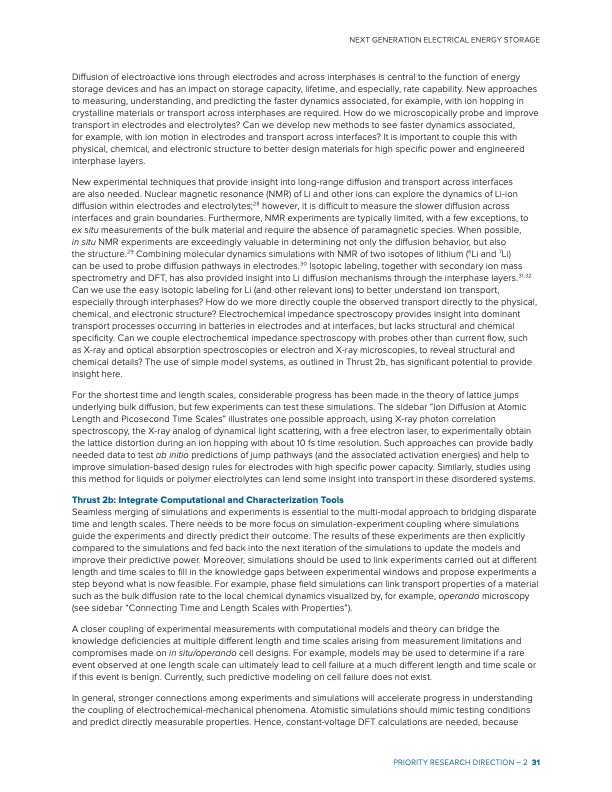
PDF Publication Title:
Text from PDF Page: 037
Diffusion of electroactive ions through electrodes and across interphases is central to the function of energy storage devices and has an impact on storage capacity, lifetime, and especially, rate capability. New approaches to measuring, understanding, and predicting the faster dynamics associated, for example, with ion hopping in crystalline materials or transport across interphases are required. How do we microscopically probe and improve transport in electrodes and electrolytes? Can we develop new methods to see faster dynamics associated, for example, with ion motion in electrodes and transport across interfaces? It is important to couple this with physical, chemical, and electronic structure to better design materials for high specific power and engineered interphase layers. New experimental techniques that provide insight into long-range diffusion and transport across interfaces are also needed. Nuclear magnetic resonance (NMR) of Li and other ions can explore the dynamics of Li-ion diffusion within electrodes and electrolytes;28 however, it is difficult to measure the slower diffusion across interfaces and grain boundaries. Furthermore, NMR experiments are typically limited, with a few exceptions, to ex situ measurements of the bulk material and require the absence of paramagnetic species. When possible, in situ NMR experiments are exceedingly valuable in determining not only the diffusion behavior, but also the structure.29 Combining molecular dynamics simulations with NMR of two isotopes of lithium (6Li and 7Li) can be used to probe diffusion pathways in electrodes.30 Isotopic labeling, together with secondary ion mass spectrometry and DFT, has also provided insight into Li diffusion mechanisms through the interphase layers.31,32 Can we use the easy isotopic labeling for Li (and other relevant ions) to better understand ion transport, especially through interphases? How do we more directly couple the observed transport directly to the physical, chemical, and electronic structure? Electrochemical impedance spectroscopy provides insight into dominant transport processes occurring in batteries in electrodes and at interfaces, but lacks structural and chemical specificity. Can we couple electrochemical impedance spectroscopy with probes other than current flow, such as X-ray and optical absorption spectroscopies or electron and X-ray microscopies, to reveal structural and chemical details? The use of simple model systems, as outlined in Thrust 2b, has significant potential to provide insight here. For the shortest time and length scales, considerable progress has been made in the theory of lattice jumps underlying bulk diffusion, but few experiments can test these simulations. The sidebar “Ion Diffusion at Atomic Length and Picosecond Time Scales” illustrates one possible approach, using X-ray photon correlation spectroscopy, the X-ray analog of dynamical light scattering, with a free electron laser, to experimentally obtain the lattice distortion during an ion hopping with about 10 fs time resolution. Such approaches can provide badly needed data to test ab initio predictions of jump pathways (and the associated activation energies) and help to improve simulation-based design rules for electrodes with high specific power capacity. Similarly, studies using this method for liquids or polymer electrolytes can lend some insight into transport in these disordered systems. Thrust 2b: Integrate Computational and Characterization Tools Seamless merging of simulations and experiments is essential to the multi-modal approach to bridging disparate time and length scales. There needs to be more focus on simulation-experiment coupling where simulations guide the experiments and directly predict their outcome. The results of these experiments are then explicitly compared to the simulations and fed back into the next iteration of the simulations to update the models and improve their predictive power. Moreover, simulations should be used to link experiments carried out at different length and time scales to fill in the knowledge gaps between experimental windows and propose experiments a step beyond what is now feasible. For example, phase field simulations can link transport properties of a material such as the bulk diffusion rate to the local chemical dynamics visualized by, for example, operando microscopy (see sidebar “Connecting Time and Length Scales with Properties”). A closer coupling of experimental measurements with computational models and theory can bridge the knowledge deficiencies at multiple different length and time scales arising from measurement limitations and compromises made on in situ/operando cell designs. For example, models may be used to determine if a rare event observed at one length scale can ultimately lead to cell failure at a much different length and time scale or if this event is benign. Currently, such predictive modeling on cell failure does not exist. In general, stronger connections among experiments and simulations will accelerate progress in understanding the coupling of electrochemical-mechanical phenomena. Atomistic simulations should mimic testing conditions and predict directly measurable properties. Hence, constant-voltage DFT calculations are needed, because NEXT GENERATION ELECTRICAL ENERGY STORAGE PRIORITY RESEARCH DIRECTION – 2 31PDF Image | Next Generation Electrical Energy Storage

PDF Search Title:
Next Generation Electrical Energy StorageOriginal File Name Searched:
BRN-NGEES_rpt-low-res.pdfDIY PDF Search: Google It | Yahoo | Bing
Sulfur Deposition on Carbon Nanofibers using Supercritical CO2 Sulfur Deposition on Carbon Nanofibers using Supercritical CO2. Gamma sulfur also known as mother of pearl sulfur and nacreous sulfur... More Info
CO2 Organic Rankine Cycle Experimenter Platform The supercritical CO2 phase change system is both a heat pump and organic rankine cycle which can be used for those purposes and as a supercritical extractor for advanced subcritical and supercritical extraction technology. Uses include producing nanoparticles, precious metal CO2 extraction, lithium battery recycling, and other applications... More Info
| CONTACT TEL: 608-238-6001 Email: greg@infinityturbine.com | RSS | AMP |